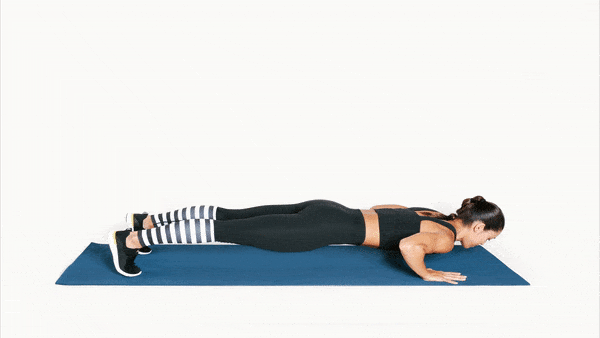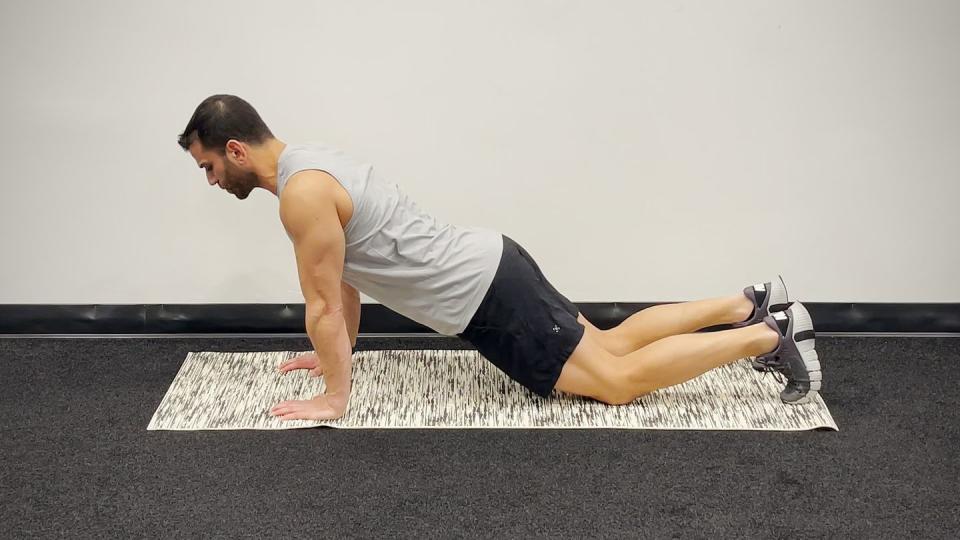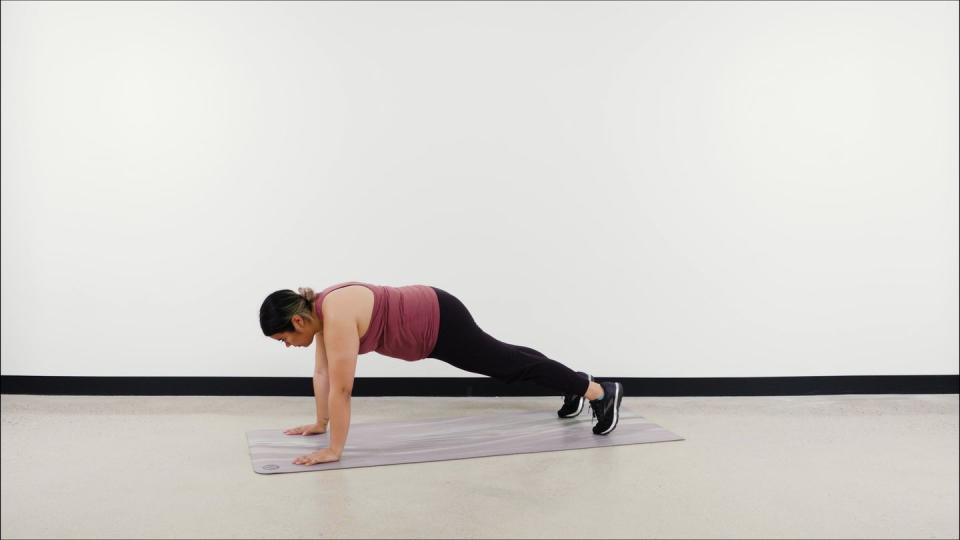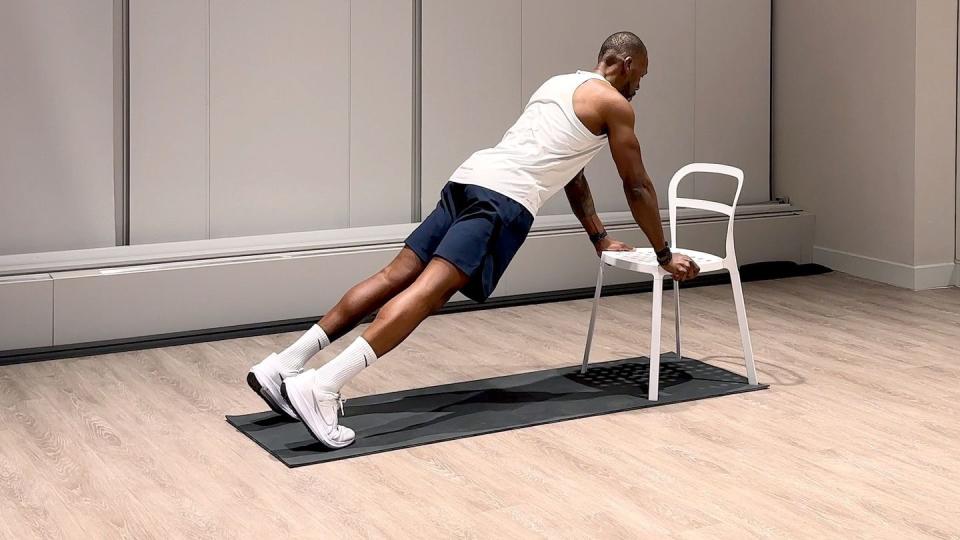These Push-Up Variations Strengthen Your Upper Body for Better Bike Handling and More Comfort

Be honest: When you do push-ups, are you doing real push-ups? Or are you worming your way up to plank and speeding through half-reps? Considering how tough it is to do a legit push-up, these variations are tempting.
Unfortunately, relying on momentum or movement compensations defeats the point of the push-up, which is to build core and upper-body strength that will help you perform better on the bike.
Learning push-up variations will help you gradually work your way up to doing a full push-up the right way. So, for a beginner-friendly push-up progression, we spoke with Jessie Duppler, P.T., D.P.T., creator of the Chain Reaction Strength Revolution program for cyclists. She shared why this classic movement belongs in your strength routine and a plan for doing a push-up you can be proud of showing off.
Why Cyclists Need Push-Up Variations
While upper-body work is sometimes a hard sell in the cycling community, Duppler has a few convincing arguments for incorporating push-ups into your weekly workouts. First she cites bone density, which strength training increases. “Upper-body work helps protect against clavicular and arm fractures, which we tend to see, especially in mountain bikers. It helps to keep the bones strong, which can prevent worse injury if you tumble,” Duppler says.
Because the push-up targets the pectoral (chest) muscles, biceps (front of upper arm), and triceps (back of upper arm), they can help improve your ability to control and maneuver the bike, too. “Push-ups can definitely help with arm strength, especially if you’re a mountain biker and you’re working on lifting up on big ups. Most of that should come more from your core and hip positioning, but it can be helpful, obviously, to have a bit more arm strength up top, too,” explains Duppler.
Push-ups are also just as much a core exercise as an upper-body move because you are engaging the abdominal and back muscles while you hold a plank. “[These] are the same muscles that stabilize your hips when you’re pedaling,” Duppler. When the hips are stable, you’re better able to generate power with your pedal stroke.
Why a Traditional Push-Up Is So Hard
The push-up looks simple enough, yet so many people struggle to master it. “I think part of that is because it’s such a core exercise,” Duppler explains. “It looks like an upper-body exercise, but your core really has to be involved.” So, any weakness in your abdominals, back, hips, or glutes will hamper your ability to do a proper push-up.
There’s also the matter of physics. “You have your whole bodyweight, and you’re fighting gravity, too,” Duppler says. “And because you’re in a plank position, it’s a pretty long lever arm from your toes to your shoulders to have to be able to push-up.”
5 Push-Up Variations to Help You Progress
To learn how to do a push-up correctly, follow this push-up progression, starting at the beginning with knee planks. If you’re in the middle of your push-up journey, you can probably jump in at a step that’s in line with your current levels of strength and ability.
Ideally, you should be able to perform three sets of six reps before moving on to the next step. For planks, make sure you can maintain the hold for at least 30 seconds at a time. The last few reps or seconds of each round should feel challenging. So, if you’re cruising through without a struggle, you can add a couple of reps, increase the hold, or transition to the next exercise in the progression.
Because push-ups are a bodyweight activity, it’s okay to do them almost every day as long as you allow one day per week for rest and recovery. “You want to make sure you’re doing them at least three times a week to make sure you’re loading those muscles enough and frequently enough to see gains,” Duppler says.
1. Knee Plank Hold

How to do it:
Start on all fours with hands a little wider than shoulder-width apart, palms spread, and fingers facing forward.
Rest knees on the ground so that hips are extended and torso and upper legs are in a straight line. Engage core and glutes. Keep neck neutral and maintain a flat back.
Hold the position for at least 30 seconds before resting for 30-60 seconds.
Repeat 2 more times.
Trainer tip: Don’t lock out your arms. “Make sure you have a soft bend in your elbows,” Duppler says. “When you lock out your elbows, you depend on your joints to stabilize you instead of your muscles.”
2. Kneeling Push-Up
How to do it:
Start in a knee plank position. Keep core engaged and hips tucked, bend elbows and lower chest toward the ground.
At the bottom, push through the palms and return to a knee plank.
Repeat. Do 6-10 reps, resting for a minute between sets. Do 3 sets.
Trainer’s tip: It’s okay if you can’t bring your chest all the way to the ground. “It doesn’t have to be huge,” Duppler says. “I always tell people, ‘own the range you have, first.’ So whatever range feels challenging but doable, start there.”
3. Plank Hold

How to do it:
Lie facedown in a plank position with hands a little wider than shoulder-width apart and toes tucked under; weight should be distributed between palms and the balls of feet.
Maintaining a flat back and neutral neck, engage core and glutes.
Hold the position for at least 30 seconds before resting for 30-60 seconds.
Repeat 2 more times.
Trainer’s tip: Push through the palms to keep the shoulders active; don’t allow the chest to sag toward the ground.
4. Incline Push-Up

How to do it:
Start in a high plank position with hands on the edge of a bench, step, or couch, with shoulders are directly over wrists. Keep core, glutes, and legs engaged.
Bend elbows and lower body toward the bench in one straight line.
Push back up to plank.
Repeat. Do 6-10 reps, resting for a minute between sets. Do 3 sets.
Trainer’s Tip: Be sure your hands are not much wider than your shoulders and that when you bend your arms, your elbows don’t flare out too far.
5. Push-Up
How to do it:
Start in a high plank position with hands a little wider than shoulder-width apart. Engage core and glutes.
Maintaining a flat back and neutral neck, bend elbows to lower chest toward the ground. 3. Once you’ve gone as low as you can, push back up to plank.
Repeat. Do 6-10 reps, resting for a minute between sets. Do 3 sets.
Trainer’s tip: Duppler doesn’t subscribe to “nose-to-the-ground” military standards, “but you should be able to get fairly far down so that your elbows are a steep angle,” she says. However, as with knee push-ups, you can start with a small range of motion and gradually go deeper. Just be careful not to sacrifice form for depth.
Elevate Your Push-Up Variations
Looking for even more challenging push-up variations? Once you can do three sets of 10 to 15 reps, you can add intensity by slowing down your tempo, elevating your feet, or narrowing your base with a “diamond push-up” (using thumbs and forefingers to create a diamond or triangle shape) set-up under your chest.
You Might Also Like

